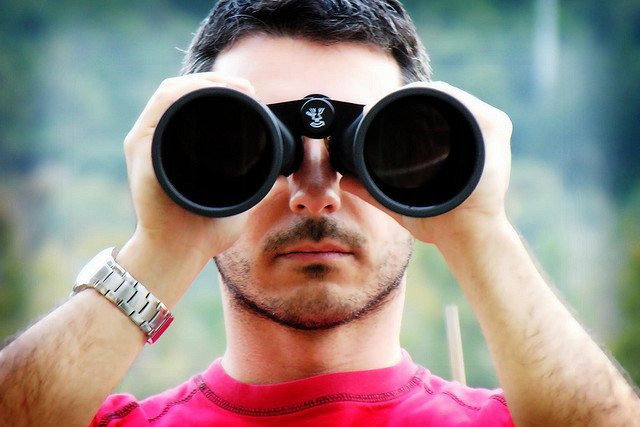
Based on the situation you’re buying your binoculars for, consider these suggestions to best fit your purchase. These are just suggestions and need not be strictly adhered to. Buying a pair near the outlined parameters is optimal.
To understand magnification and optic lens sizes, here is an example. 7×40 is a magnification of 7 times with a 40 millimeter diameter of the optic lens. See terms at the bottom of this guide for an in-depth explanation.
Bird-watching
 Magnification: Ideal magnification is nearly or exactly 8×40. Above 10x you will need a tripod to stabilize the image.
Magnification: Ideal magnification is nearly or exactly 8×40. Above 10x you will need a tripod to stabilize the image.- Optic lens size: 20 mm to 40 mm lens size is suitable for day-time.
- Field-of-view: Narrow is okay since you will be observing small objects from not terribly far away.
- Waterproofing/resistance: Water resistant is okay in case of rain, but use caution and opt for waterproof to keep your scope in good condition.
- Weight: Keep it light. You will constantly be putting the binoculars up to your face.
Hiking
- Magnification: 10×25 or 8×40. Do not go higher than 10x unless you want to carry a tripod.
- Optic lens size: For daytime, 25mm to 35mm is good. For dawn/dusk viewing, 40mm to 50mm is necessary although that means a bigger (usually heavier) pair.
- Field-of-view: For observing countryside, a wide field-of-view is good. To get details of animals, narrow down your field-of-view.
- Waterproofing/resistance: Waterproof is best for temperature changes experienced between night and day and possible rain.
- Weight: As light as can be. Compact lenses are light.
Hunting
Hunting is a little different than other categories because recommendations change per hunters’ requirements for intended use.
- Magnification: Most likely, field-of-view is more important so a magnification of 7x to 8x is suitable or up to 10×42.
- Optic lens size: Same as hiking. Though for hunting, compact is better.
- Field-of-view: For scouting, a wider field-of-view is better.
- Waterproofing/resistance: For changes in temperature waterproof is better unless it’s an excellent water resistant pair.
- Weight: Light to medium.
Sports
- Magnification: 6×20 to 8×20. Remember, as magnification increases, field-of-view decreases.
- Optic lens size: Keep it small. 20 mm is compact and allows you to see well in daylight, during most sporting events.
- Field-of-view: Sometimes wider is better to catch all the action.
- Waterproofing/resistance: Water resistant is okay unless you’re white-water rafting in which case you should definitely get waterproof.
- Weight: Light since you’ll be picking them up/putting them down often.

Real photograph of Saturn taken with a Celestron C8 @ f/20 telescope and a Philips SPC900NC webcam; processed for sharpness.
Star-gazing/astronomy
- Magnification: 10×50 to 25×100.
- Optic lens size: The higher the better because of poor light conditions at night. Undoubtedly, these binoculars will require a tripod.
- Field-of-view: Narrow is okay since you’re likely zooming in on a specific part of the sky.
- Waterproofing/resistance: Water resistant is okay unless you will experience a drastic change in temperature in the day.
- Weight: Heavy. To see better, your binoculars will be bigger and heavier.
As always, I recommend going to a sports store in your area just to test and play with different pairs within your requirements and budget. You need not purchase right away, but you will be better informed if you buy your pair online.
For more information on what to look for in binoculars, see my article on choosing the right pair of binoculars.
Terms to understand our binocular suggestions:
Field-of-view. The range of visibility of the subject that you observe through the binoculars. A wide field-of-view is like a wide-angle in photography. For example, a wide field-of-view allows you to see the body of a bobcat from far away, while a narrow field-of-view allows you only to see its head from the same distance.
Hand shake. Occurs at magnifications above 8x or 10x. Your hand is simply not steady enough to view an image clearly without flying all over the sky unless you stabilize it with a tripod or have a wonderful “image-stabilizing” feature built in to your binoculars.
Magnification. How many times an image is enlarged. Binoculars that are labeled as 6×32 means the image you’re looking at is magnified to six times its size. *As magnification size increases, field-of-view decreases.
Optic lens. The lens on the front of the binoculars that you point at the object you want to look at. The measurement in diameter of an optic lens determines the amount of light entering your binoculars. 6×32 binoculars have an optic lens [diameter] size of 32 millimeters. *The smaller the lens size, the less light gets in. The larger the lens size, the more light gets in.
Diameter. The length of a straight line from one point in a circle to its opposite point.
Waterproof. Waterproof binoculars are sealed off from water entering either through direct contact or condensation in temperature changes. Usually waterproof binoculars will be filled with nitrogen on the inside to disallow water from condensing inside.
Water resistant. Tightly sealed screws and parts to keep water from entering, although not guaranteed protection from water.
Photo: (Large binoculars & Saturn) Gerlos,

 Your Privacy Choices
Your Privacy Choices
 The
The